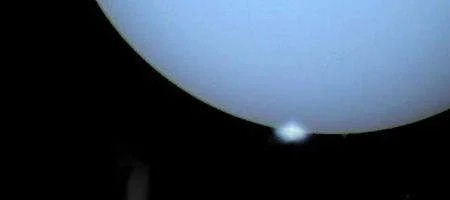Astronomers using the Hubble Space Telescope have for the first time captured images of auroras on the giant ice planet Uranus.

Very different from those seen on Earth, the auroras consist of faint, glowing dots that last for just a minute or two and are fainter than those on Earth.
Auroras are produced in the atmosphere as charged solar wind particles accelerate in the magnetosphere and are guided by the magnetic field close to the magnetic poles.
But while those on Earth are well-understood – and even those on Jupiter and Saturn – there’s very little known about the magnetosphere of Uranus.
Indeed, they’ve only been detected once before, 25 years ago, during a flyby by the Voyager 2 spacecraft. This time, though, the auroras look rather different.
Uranus is unlike the other planets in that it it lies on its side, rlative to the sun. Its magnetic axis is both offset from the center of the planet and tilts at an angle of 60 degrees from the rotational axis. Scientists theorize that the planet’s magnetic field is generated by a salty ocean within the planet.
When Voyager 2 made its flyby, Uranus was near its solstice, with its rotational axis pointed toward the sun. That meant the magnetic axis was at a large angle from the solar wind flow, producing a magnetosphere similar to the Earth’s.
Under those 1986 solstice conditions, the auroras lasted longer than the newly-seen ones and were mainly seen on the nightside of the planet.
The new set of observations, however, were made when the planet was near equinox, with the axis almost perpendicular to the solar wind flow. Because the planet’s magnetic axis is tilted, the daily rotation of Uranus during the period around the equinox causes each of its magnetic poles to point once a day toward the sun.
“This configuration is unique in the solar system,” says Laurent Lamy of the Observatoire de Paris.
A better understanding of Uranus’ magnetosphere could help scientists test their theories of how Earth’s magnetosphere functions, says Fran Bagenal, a planetary scientist with the University of Colorado in Boulder.
“We have ideas of how things work on Earth and places like Jupiter and Saturn, but I don’t believe you really know how things work until you test them on a very different system,” she says.






